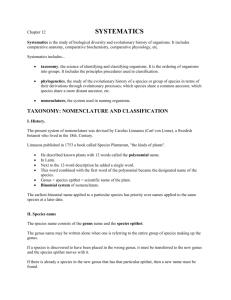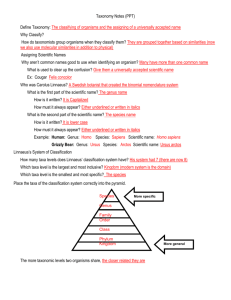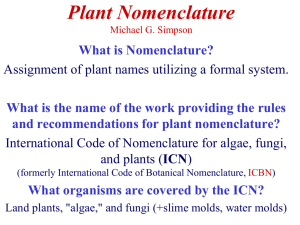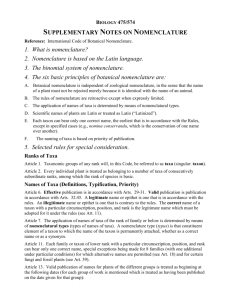1. Dendrology Systematics
advertisement
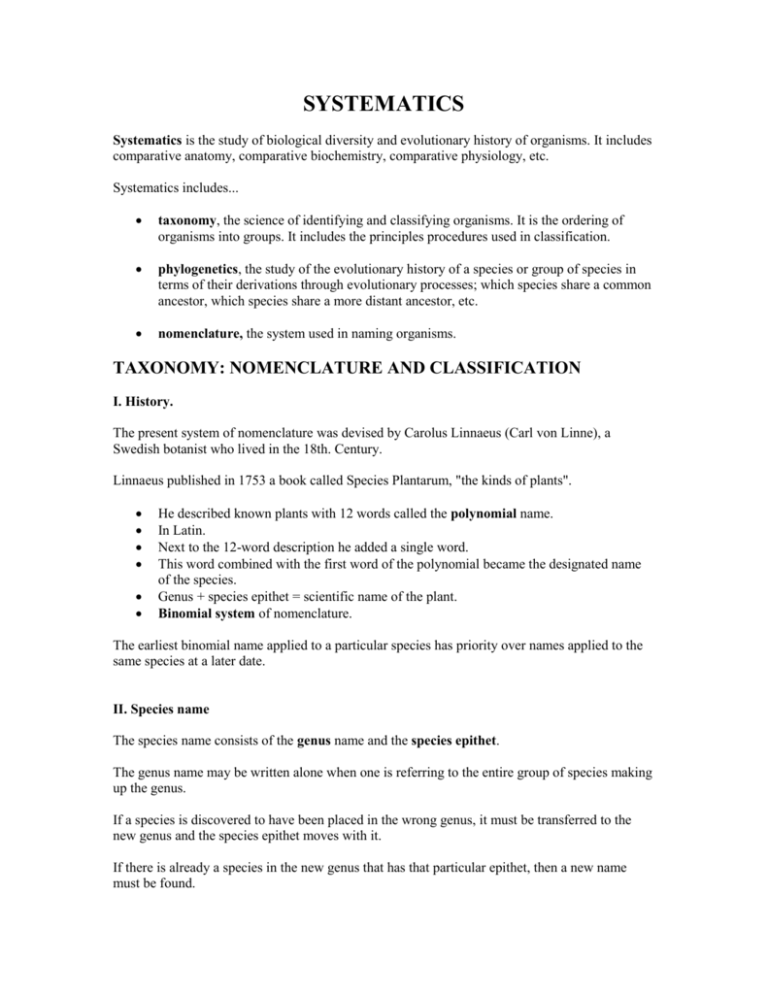
SYSTEMATICS Systematics is the study of biological diversity and evolutionary history of organisms. It includes comparative anatomy, comparative biochemistry, comparative physiology, etc. Systematics includes... taxonomy, the science of identifying and classifying organisms. It is the ordering of organisms into groups. It includes the principles procedures used in classification. phylogenetics, the study of the evolutionary history of a species or group of species in terms of their derivations through evolutionary processes; which species share a common ancestor, which species share a more distant ancestor, etc. nomenclature, the system used in naming organisms. TAXONOMY: NOMENCLATURE AND CLASSIFICATION I. History. The present system of nomenclature was devised by Carolus Linnaeus (Carl von Linne), a Swedish botanist who lived in the 18th. Century. Linnaeus published in 1753 a book called Species Plantarum, "the kinds of plants". He described known plants with 12 words called the polynomial name. In Latin. Next to the 12-word description he added a single word. This word combined with the first word of the polynomial became the designated name of the species. Genus + species epithet = scientific name of the plant. Binomial system of nomenclature. The earliest binomial name applied to a particular species has priority over names applied to the same species at a later date. II. Species name The species name consists of the genus name and the species epithet. The genus name may be written alone when one is referring to the entire group of species making up the genus. If a species is discovered to have been placed in the wrong genus, it must be transferred to the new genus and the species epithet moves with it. If there is already a species in the new genus that has that particular epithet, then a new name must be found. The rules that govern the use of scientific names in botany are codified in the International Code of Botanical Nomenclature. Each species usually has type specimen kept in a museum or herbarium. The type specimen serves as the basis for comparison with other specimens in determining whether they are members of the same species or not. III. Subspecies and varieties. Species may be grouped into subspecies and varieties. All members of a subspecies or variety resemble one another and share one or more features not present in other subspecies and varieties not present in other members of the species. The name of the subspecies consists of the species binomial name and the variety’s name, e. g. Prunus persica var. nectarina; Prunus persica var. persica. IV. Broad taxonomic categories. Linnaeus recognized three kingdoms, which, until recently were the most inclusive unit used in biological classification. Plant, animal and mineral kingdoms. Several taxonomic categories were added between the genus and the kingdom levels Species are grouped into genera (sing. Genus). Genera into families; families into orders; orders into classes; classes into divisions; divisions into kingdoms. Augustin Pyramus de Candolle (1778-1841) added the category Division. A taxonomic grouping is called a taxon. Taxonomy is hierarchical: taxa are grouped into broader taxa; groups within groups. The ending of the name of a particular taxon makes it possible to recognize the taxon at that level. e. g. Aspleniaceae. The ending –aceae is used for families. All family names end in –aceae. Phylogeny In a classification scheme that accurately reflects phylogeny, every taxon is monophyletic. Phylogenetic classification should be monophyletic. Monophyletic means that all the members of a taxon regardless of rank, are descendants of a common ancestor. No descendant should be excluded Monophyly is often difficult to know with certainty. Organisms in a polyphyletic group evolved from different ancestors. Some widely accepted taxa contain members descended from more than one ancestral line. Such taxa are said to be polyphyletic. Other taxa include a common ancestor but not all it’s descendants. These taxa are said to be paraphyletic. THE MAJOR GROUPS OF ORGANISMS: BACTERIA, ARCHAEA AND EUKARYA Some scientists recognize a taxon above the kingdom called domain. Bacteria, Archaea and Eukarya. Bacteria and Eukarya are prokaryotes. The Eukarya includes all the eukaryotes: protists, fungi, plants and animals. The divisions within the eukaryotic kingdoms are not clear-cut. Plants, animals and fungi are probably monophyletic groups, and the kingdom Protista is paraphyletic. Kingdom Plantae. Plants are... Multicellular. Eukaryotes. Autotrophs; a few species have become heterotrophs. Cell wall that contains cellulose, plastids and photosynthetic pigments. In the most advanced member, the haploid generation, the gametophyte, has become very reduced. Presence of an embryo in the sporophytic phase of the life cycle. Alternation of generations. o Sporic meiosis or alternation of generation o The sporophyte or diploid individual produces spores by meiosis; the spores do not function as gametes but undergo mitosis and give rise to multicellular haploid individuals called gametophytes; the haploid gametophytes produce haploid gametes that fuse to form diploid sporophytes. DIVISIONS (PHYLA) OF THE PLANT KINGDOM Liverworts (Division Hepatophyta) Mosses (Division Bryophyta) Hornworts (Division Anthocerophyta) Whisk ferns (Division Psilotophyta) Club mosses (Division Lycophyta) Horsetails (Division Sphenophyta) Ferns (Division Pterophyta) Conifers (Division Coniferophyta) Cycads (Division Cycadophyta) Ginkgos (Division Ginkgophyta) Gnetophytes (Division Gnetophyta) Flowering Plants (Division Anthophyta) Monocots (Class Liliopsida) Dicots (Class Magnoliopsida) Bryophytes (no vascular tissue) Seedless vascular plants (vascular, no seeds) Gymnosperms (vascular, naked seeds) Angiosperms (vascular, protected seeds)

